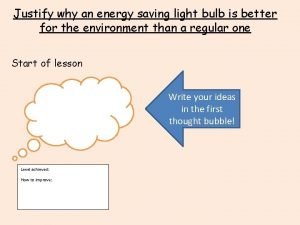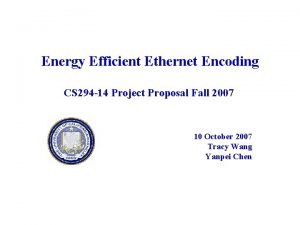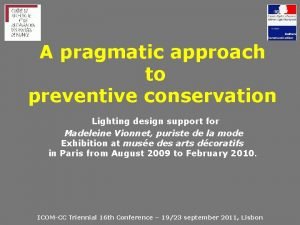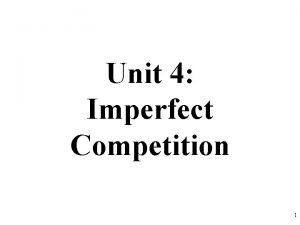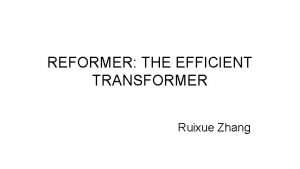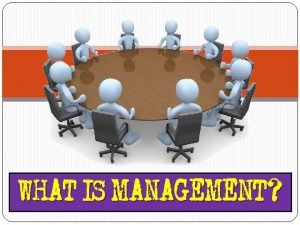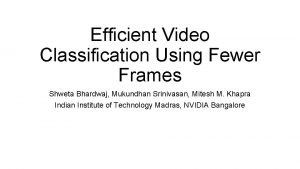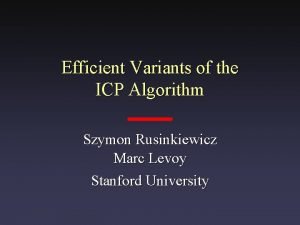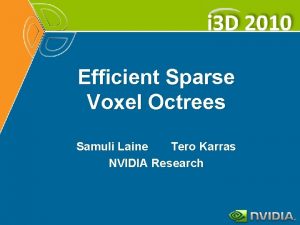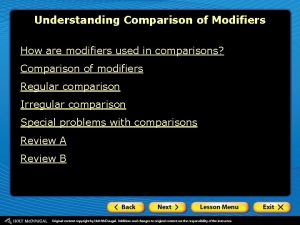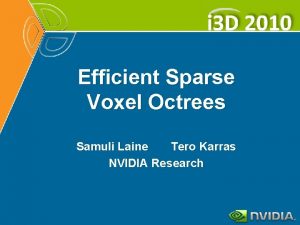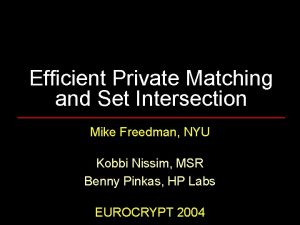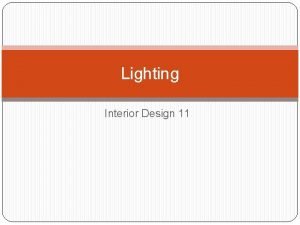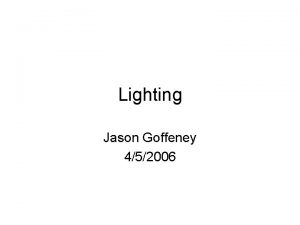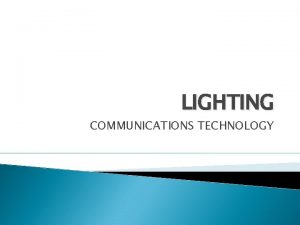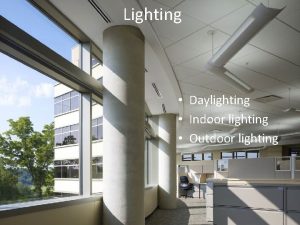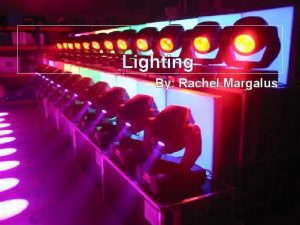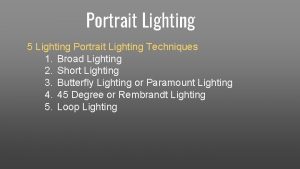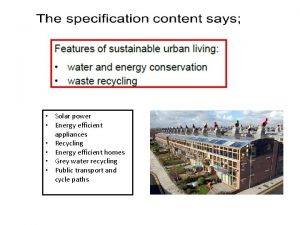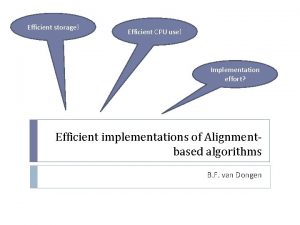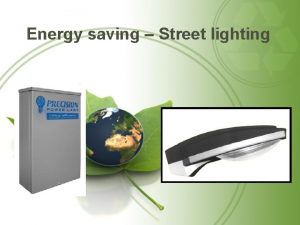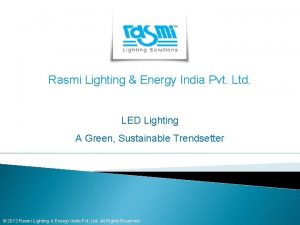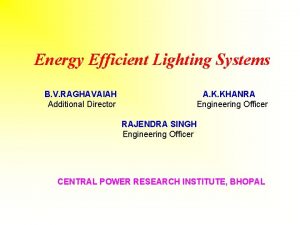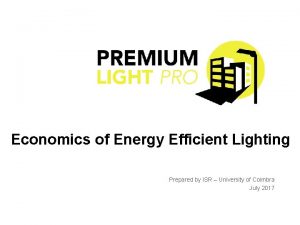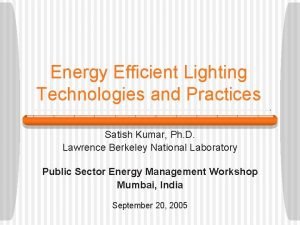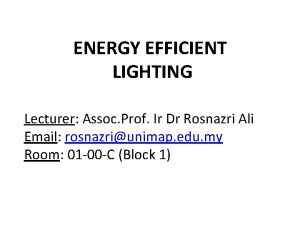Lighting Design Energy Efficient Lighting Design Ways to











































- Slides: 43

Lighting Design: Energy Efficient Lighting Design: Ways to Make the Right Choices Sanford Lighting Design Palo Alto, CA 1

How do you decide how to light your space? • Assess how much general light you need for the space • Consider visual tasks and where you need light • Determine what highlighting and other lighting techniques you can use to enhance the space • Compare energy efficiencies and choose a source • Choose a color temperature and confirm the color rendering index • Consider where the light is going and choose an appropriate fixture type • Select the right auxiliary devices, if needed, for the lighting fixtures you are using 2

Energy Efficiency Terms Lumens Output is the measure luminous flux (F) - the total amount of light energy emitted from a source. It is expressed in lumens. Wattage Power is measured in watts (W) - the rate at which energy is used. Efficacy = lumens per watt Efficacy is lighting efficiency, measured in amount of output in lumens per watt.

Use of Electrical Power 1000 W = 1 k. W Energy use is measured in amount of power used over time. Measured in Whrs (Watthours) or in k. Whrs

Light Efficiency (efficacy) The values of lumens or lumens per watt (lpw) are often displayed on a package. Like gas mileage, the measurement of light efficacy is similar to miles per gallon. The higher the number the more efficient the light source. Standard incandescent A-lamp LED 960 lumens/8 W = 120 lpw 1190 lumens/75 W = 15. 8 lpw

Luminous Flux Sample list of average lumens for traditional sources 32 W

Comparisons 13 lpw 18. 6 lpw 65 lpw 72. 2 lpw

White light – Color Temperature C C T – Correlated color temperature is the color of a light expressed in degrees K. Light sources that are called “white” can have a range of color temperatures. In residences, they usually are between 2700 K and 4000 K.

Color temperature Many sources, such as CFLs and LEDs come in a variety of colors.

Color rendering index (CRI) The Color Rendering Index (CRI) measures how well colors are rendered compared to a reference light source on a comparative scale, from 0 – 100. By definition, daylight has a CRI of 100. At lower brightnesses, the incandescent and halogen sources by definition have a CRI of 100. The CRI is critical for distinguishing color, or when you want to show skin tones accurately.

California’s Title 24 Compliance q Minimum efficacy is established q CRI must be 90 or higher q CCT of 2700 K to 4000 K

What do you want to light? Step 1 - Consider your general lighting Lighting a vertical surface gives a sense of brightness Recessed downlighting is often the most basic lighting technique

Step 2 Apply high-impact techniques: Accent Wall-washing Niches and shelves Grazing Uplighting Patterns Exterior views Randall Whitehead 13

Apply high-impact techniques: Accent 14

Apply high-impact techniques: Wall-washing Chanel Encore 2010 IALD Award Winner, Fisher Marantz, Stone Las Vegas, 15 NV

Apply high-impact techniques: Grazing exaggerates texture. 16

Apply high-impact techniques: Wall-washing vs grazing 17

Apply high-impact techniques: Niches and shelves From above, point source From above, linear source

Apply high-impact techniques: Niches and shelves From below, linear source From above and below, to light glass

Apply high-impact techniques: Niches and shelves From above, point sources too spread out

Apply high-impact techniques: Uplighting 21

Apply high-impact techniques: Patterns Pattern based on beam layout Pattern roughly along cabinets 22

Apply high-impact techniques: Exterior views Creates a larger visual space 23

How Much Light Do You Need? Depends on room size, ceiling height, reflectances of surfaces, quantities of fixtures

Light Sources are tending towards LEDs Incandescents, including halogens, produce light with a glowing filament. They have excellent color, short lives, and use energy to generate heat, making them inefficient light sources.

Light Sources are tending towards LEDs Fluorescents and compact fluorescents (CFLs) have electrodes that generate a high voltage to create a mercury vapor, and emit ultraviolet light. The ultraviolet light strikes a phosphorescent coating on the inside of the bulb and causes it to glow with visible light. Benefits: Low cost High efficacy Long life. Color emitted from the lamp: From mixture of phosphors On the inside of the lamp.

Light Sources are tending towards LEDs (light emitting diodes) generate light by passing current over an diode, a two terminal electronic component that looks like a tiny metal plate. They are extremely compact and durable with a 50, 000 – 100, 000 hour life or longer.

White and Colored LEDs New developments produced a white LED with the inclusion of a phosphorescent inner coating, similar to a fluorescent lamp. These are sometimes referred to as phosphor based white LEDs. There are white LEDs, RGB (red, green, blue) LEDs, RGBW (red, green, blue, white) LEDs and RGBWA (includes amber) LEDS. All have increasing lpw values, improving output and controls.

LED As an alternative to multitudes of small LEDs, lamps were developed with much larger LED modules. Known as high power LED (HPLED) they greatly increase the amount of emitted light but introduce a major heat issue. Diodes are very sensitive to heat and will fail in seconds if too hot. This problem is solved a number of ways; heat sinks, heat distribution fins and even tiny fans. All this technology increases the cost of each lamp.

LEDs need drivers LEDs require drivers to operate. They take an incoming alternating voltage (usually a range, and should include 120 V) and change it to a constant current lower voltage the LEDs need. (usually 12 V or 24 V)

LEDs need drivers Drivers are often alongside the fixture, provided as part of the installation.

LEDs need drivers Most dedicated LED fixtures will state the characteristics of the integrated LED driver.

Lighting Design – what do you need to do? Think about your specific application, and Consider the output Consider the color Consider the distribution

Making Fixture Choices Replacement lamps Uses existing fixtures and lamp bases

Making Fixture Choices Recessed downlight trims that include the LEDs can replace existing trims and keep existing housing. Fixture locations remain the same. Choose appropriate aperture (opening) size, fixed or adjustable, output, color, beam spread, trim

Making Fixture Choices- Recessed downlights New lighting locations, new fixtures and IC (insulated ceiling) rating for residential

Making Fixture Choices - Sconces Glare could be an issue

Making Fixture Choices – Linear lights

Making Fixture Choices – Linear lights Under cabinet lights make the cabinet look like it’s floating

Making Fixture Choices Undercabinet tasks Hide fixtures under cabinets where tasks take place.

Controls Drivers are usually dimmable. Each driver type must be compatible with the dimmer type on the wall or the automated control system. It is important to check the dimming protocol for each dimmable driver. Often a replacement LED lamp or recessed trim assumes the input will be from an incandescent residential dimmer. But some companies have products that work with a variety of sources and drivers.

Controls – Protocols for dimming LED drivers Compatibility Technical paper 1000. bulbs

Thank you! Questions?
 Productively efficient vs allocatively efficient
Productively efficient vs allocatively efficient Allocative efficiency
Allocative efficiency Productively efficient vs allocatively efficient
Productively efficient vs allocatively efficient Productively efficient vs allocatively efficient
Productively efficient vs allocatively efficient Productive inefficiency and allocative inefficiency
Productive inefficiency and allocative inefficiency Gods ways are not our ways
Gods ways are not our ways Sankey diagram energy efficient light bulb
Sankey diagram energy efficient light bulb Energy efficient construction
Energy efficient construction Intel energy efficient ethernet
Intel energy efficient ethernet Energy-efficient embedded systems
Energy-efficient embedded systems Energy energy transfer and general energy analysis
Energy energy transfer and general energy analysis Energy energy transfer and general energy analysis
Energy energy transfer and general energy analysis Airport lighting cans
Airport lighting cans Conservation lighting design
Conservation lighting design Emergency lighting design nz
Emergency lighting design nz Objective of warehouse management system
Objective of warehouse management system Socially efficient quantity
Socially efficient quantity Evidence supporting efficient market hypothesis
Evidence supporting efficient market hypothesis Reformer: the efficient transformer
Reformer: the efficient transformer Systematic arrangement
Systematic arrangement Examples of explicit instruction
Examples of explicit instruction Efficient video classification using fewer frames
Efficient video classification using fewer frames Efficient variants of the icp algorithm
Efficient variants of the icp algorithm Efficient variants of the icp algorithm
Efficient variants of the icp algorithm Efficient sparse voxel octrees
Efficient sparse voxel octrees Nvdla
Nvdla Efficient markets theory
Efficient markets theory Efficient market hypothesis
Efficient market hypothesis Four h group details
Four h group details Efficient elements for presentations
Efficient elements for presentations Efficient quantity
Efficient quantity Efficient scale quantity
Efficient scale quantity Master data management project plan
Master data management project plan Cure: an efficient clustering algorithm for large databases
Cure: an efficient clustering algorithm for large databases Efficient securities markets imply that
Efficient securities markets imply that Strategic fit
Strategic fit Using the body in an efficient and careful way is
Using the body in an efficient and careful way is Random walk efficient market hypothesis
Random walk efficient market hypothesis An efficient representation for irradiance environment maps
An efficient representation for irradiance environment maps Modifiers with comparatives
Modifiers with comparatives Scalable synonym
Scalable synonym Efficient sparse voxel octrees
Efficient sparse voxel octrees Efficient private matching and set intersection
Efficient private matching and set intersection Efficient estimation of word representations
Efficient estimation of word representations






